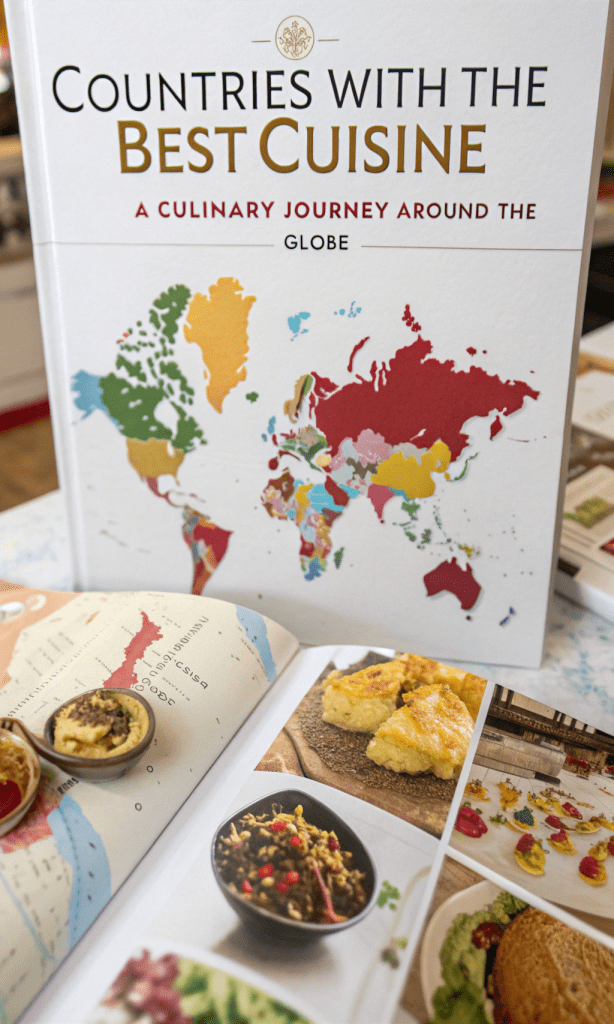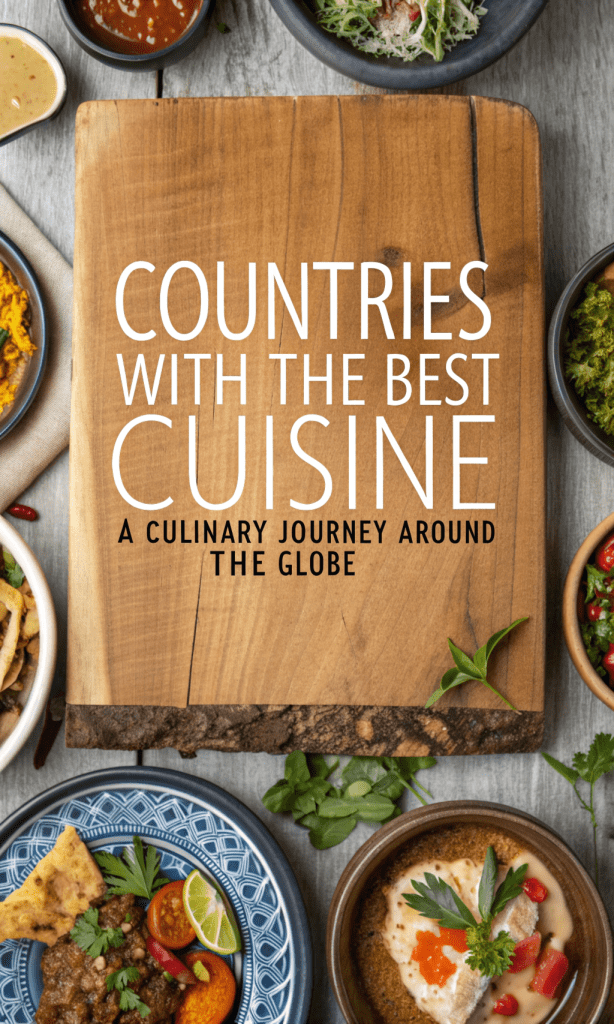
Countries with the best cuisine offer a vibrant tapestry of flavors, traditions, and stories that captivate food lovers worldwide. From the aromatic spices of India to the delicate artistry of Japanese sushi, these cuisines reflect centuries of culture, geography, and innovation. This article explores the top countries renowned for their culinary excellence, diving into the origins, preparation methods, nutritional values, and unique characteristics of their iconic dishes. Join us on a mouthwatering journey to discover why these cuisines stand out and how you can bring their flavors to your kitchen.
Italy: The Heart of Mediterranean Cuisine
Origins and Cultural Significance
Italy’s cuisine, born from the Mediterranean’s fertile lands, blends simplicity with bold flavors. Dating back to ancient Rome, Italian food evolved through regional diversity, with each area contributing unique dishes. From Tuscany’s rustic soups to Sicily’s seafood, Italy’s culinary heritage reflects its history of trade, conquest, and local ingredients. The emphasis on fresh, high-quality produce defines Italian cooking, making it a global favorite.
Iconic Dishes and Preparation
Italian cuisine shines through dishes like pasta, pizza, and risotto. Spaghetti alla Carbonara, a Roman classic, combines guanciale (cured pork cheek), eggs, pecorino cheese, and black pepper for a creamy, savory dish. To make it, cook spaghetti al dente, fry guanciale until crisp, mix eggs and cheese for a sauce, and toss everything together off heat to avoid scrambling. Margherita Pizza, originating in Naples, uses a thin crust topped with tomato, mozzarella, and basil. Bake it in a wood-fired oven at 450°C (842°F) for 10-12 minutes for authentic results.
Nutritional Value
Italian cuisine balances flavor and nutrition. Pasta provides complex carbohydrates for sustained energy, while olive oil, a staple, offers heart-healthy monounsaturated fats. Tomatoes, rich in lycopene, support antioxidant health. However, dishes like carbonara can be high in saturated fats due to cheese and pork, so moderation is key. A typical serving of spaghetti carbonara (100g) contains about 200-250 calories, 10g protein, and 12g fat.
Why It Stands Out
Italy’s cuisine excels in its versatility and accessibility. Whether it’s a quick plate of cacio e pepe or an elaborate lasagna, Italian food adapts to any occasion. Its reliance on fresh ingredients and minimal processing appeals to health-conscious diners, while its bold flavors satisfy indulgent cravings.
France: The Pinnacle of Culinary Artistry
Origins and Cultural Significance
France’s cuisine, rooted in medieval traditions, became a global benchmark through culinary pioneers like Auguste Escoffier. From the buttery pastries of Paris to the hearty stews of Provence, French food reflects a commitment to technique and refinement. The country’s emphasis on terroir—local ingredients tied to specific regions—shapes its diverse flavors.
Iconic Dishes and Preparation
Coq au Vin, a Burgundian dish, showcases France’s love for wine and slow cooking. Marinate chicken in red wine, then braise it with mushrooms, onions, and bacon for 2-3 hours until tender. Croissants, a breakfast staple, require laminated dough folded with butter, rolled, and baked to achieve their flaky texture. For a perfect croissant, chill the dough between folds to maintain layers, then bake at 200°C (392°F) for 15-20 minutes.
Nutritional Value
French cuisine balances indulgence with moderation. Coq au vin offers protein from chicken (25g per 100g serving) and antioxidants from red wine, but its bacon and butter add saturated fats (10-15g per serving). Croissants, while delicious, are calorie-dense (400 calories per 100g) due to butter. French meals often include vegetables and small portions, promoting balance.
Why It Stands Out
France’s cuisine stands out for its precision and elegance. Techniques like sous-vide and sauces like hollandaise showcase culinary artistry. The French approach to dining—savoring meals slowly with wine—enhances the experience, making it a cultural ritual as much as a meal.
Japan: The Art of Precision and Balance
Origins and Cultural Significance
Japan’s cuisine, shaped by its island geography, emphasizes seasonality and harmony. Originating over 2,000 years ago, it draws from Shinto and Buddhist principles, valuing simplicity and respect for ingredients. From sushi to tempura, Japanese food prioritizes freshness and presentation, earning UNESCO recognition for its cultural significance.
Iconic Dishes and Preparation
Sushi, particularly nigiri, highlights Japan’s seafood mastery. To make nigiri, season rice with vinegar, shape it into small balls, and top with fresh fish like tuna or salmon. Serve with soy sauce and wasabi. Ramen, a noodle soup, varies by region. For tonkotsu (pork bone broth) ramen, simmer pork bones for 12-24 hours, add noodles, and top with chashu pork, seaweed, and egg. Cook noodles for 2-3 minutes for the perfect bite.
Nutritional Value
Japanese cuisine is among the healthiest globally. Sushi provides omega-3 fatty acids from fish, supporting heart health, and rice offers carbohydrates (30g per 100g). Ramen, while nutritious, can be high in sodium (up to 2,000mg per bowl) due to broth. Fermented foods like miso add probiotics, aiding digestion. A typical nigiri serving (2 pieces) has 100-150 calories and 8g protein.
Why It Stands Out
Japan’s cuisine excels in its aesthetic and nutritional balance. The umami flavor, derived from ingredients like dashi and soy sauce, creates depth without excess. Its focus on fresh, minimally processed ingredients appeals to health-conscious diners, while intricate presentations elevate dining to an art form.

India: A Symphony of Spices and Flavors
Origins and Cultural Significance
India’s cuisine, one of the world’s oldest, reflects its diverse climates, religions, and cultures. Dating back to the Indus Valley Civilization, it blends influences from Mughal, Persian, and British traditions. Spices like turmeric, cumin, and cardamom define Indian dishes, creating bold, complex flavors that vary by region.
Iconic Dishes and Preparation
Butter Chicken, a North Indian favorite, combines marinated chicken with a creamy tomato sauce. Marinate chicken in yogurt and spices for 4 hours, grill it, then simmer in a sauce of tomatoes, butter, and cream for 30 minutes. Biryani, a rice dish, layers spiced meat with basmati rice. Cook rice partially, layer with marinated meat, and bake for 45 minutes at 180°C (356°F) to meld flavors.
Nutritional Value
Indian cuisine offers nutritional benefits but requires balance. Lentils and chickpeas, common in dishes like dal, provide protein (10-15g per 100g) and fiber. Spices like turmeric have anti-inflammatory properties. However, dishes like butter chicken are high in fat (20g per 100g) due to cream and ghee. A serving of biryani (200g) has 300-400 calories, depending on meat and oil content.
Why It Stands Out
India’s cuisine stands out for its diversity and spice mastery. Vegetarian options, like paneer tikka or chana masala, cater to varied diets, while bold flavors satisfy adventurous palates. Its adaptability—spanning street food to fine dining—makes it universally appealing.
Mexico: A Fiesta of Bold and Fresh Flavors
Origins and Cultural Significance
Mexico’s cuisine, rooted in Mesoamerican traditions, blends indigenous ingredients like corn, beans, and chilies with Spanish influences. From Aztec markets to modern taquerias, Mexican food celebrates bold flavors and communal dining. UNESCO recognizes its cultural importance, particularly for dishes like mole.
Iconic Dishes and Preparation
Tacos al Pastor, a street food staple, features pork marinated in achiote and pineapple, grilled on a spit, and served in corn tortillas. Marinate pork for 4 hours, grill at medium heat, and slice thinly. Mole Poblano, a complex sauce, combines chilies, chocolate, and spices. Simmer ingredients for 2 hours, blend, and serve over chicken or enchiladas.
Nutritional Value
Mexican cuisine balances flavor and nutrition. Corn tortillas provide fiber and carbohydrates (20g per 100g), while beans offer protein (7g per 100g). Avocados in guacamole add healthy fats. However, fried dishes like churros or excessive cheese can increase calorie counts (300-500 calories per serving). Mole, while rich, includes nutrient-dense ingredients like nuts and seeds.
Why It Stands Out
Mexico’s cuisine shines for its vibrant flavors and accessibility. Street foods like tacos are quick yet delicious, while complex dishes like mole showcase culinary depth. Its use of fresh ingredients like cilantro, lime, and avocado adds brightness, making every bite a celebration.
How to Bring These Cuisines to Your Kitchen
Tips for Authentic Cooking
- Italy: Use high-quality olive oil and fresh herbs. Invest in a pasta machine for homemade noodles.
- France: Master basic techniques like braising and pastry folding. Source fresh butter and wine.
- Japan: Buy sushi-grade fish from trusted suppliers. Practice rice seasoning for perfect sushi.
- India: Stock up on spices like cumin, coriander, and garam masala. Use a pressure cooker for quick dals.
- Mexico: Source authentic chilies and masa for tortillas. Grill meats for smoky flavors.
Where to Find Ingredients
- Local Markets: Fresh produce and spices are widely available in supermarkets or farmers’ markets.
- Specialty Stores: Asian markets for Japanese ingredients, Indian grocers for spices, or Mexican tiendas for chilies.
- Online Retailers: Websites like Amazon or specialty food sites ship global ingredients worldwide.
Adapting for Dietary Needs
- Gluten-Free: Use rice noodles for Japanese dishes or corn tortillas for Mexican recipes.
- Vegetarian/Vegan: Swap meat for tofu in Indian curries or mushrooms in French stews.
- Low-Calorie: Reduce oil and cream in Indian and French dishes; opt for grilled proteins in Mexican recipes.
Nutritional Comparison of Iconic Dishes
| Dish | Calories (per 100g) | Protein (g) | Fat (g) | Key Nutrients |
|---|---|---|---|---|
| Spaghetti Carbonara | 200-250 | 10 | 12 | Carbs, calcium, saturated fats |
| Coq au Vin | 150-200 | 25 | 10-15 | Protein, antioxidants |
| Nigiri Sushi | 100-150 | 8 | 2-4 | Omega-3, carbs, probiotics |
| Butter Chicken | 250-300 | 15 | 20 | Protein, fiber, anti-inflammatory |
| Tacos al Pastor | 200-250 | 12 | 10 | Fiber, protein, healthy fats |
Why These Countries Top the Culinary World
Countries with the best cuisine share common traits: a deep respect for ingredients, a balance of flavors, and a cultural story behind every dish. Italy’s simplicity, France’s elegance, Japan’s precision, India’s vibrancy, and Mexico’s boldness create a global culinary mosaic. Each cuisine adapts to modern tastes while preserving tradition, making them accessible yet extraordinary.
Global Influence
These cuisines dominate restaurants, food trucks, and home kitchens worldwide. Italian pizzerias thrive in New York, Japanese sushi bars flourish in London, and Indian curry houses are staples in Dubai. Their universal appeal lies in their ability to evolve while retaining authenticity.
How to Experience Them
- Travel: Visit Italy’s trattorias, France’s bistros, Japan’s izakayas, India’s dhabas, or Mexico’s taquerias for authentic flavors.
- Restaurants: Seek Michelin-starred venues or local eateries specializing in these cuisines.
- Cooking Classes: Enroll in workshops to learn techniques like sushi rolling or French pastry making.
- Festivals: Attend food festivals like Italy’s Slow Food Fair or Mexico’s Day of the Dead celebrations for immersive experiences.
Countries with the best cuisine—Italy, France, Japan, India, and Mexico—offer more than just food; they deliver culture, history, and passion on every plate. From the simplicity of a Margherita pizza to the complexity of mole poblano, these cuisines invite exploration and creativity. Try their recipes at home, savor their nutritional benefits, and celebrate the diversity that makes global cuisine so extraordinary. Whether you’re a novice cook or a seasoned chef, these culinary traditions promise to inspire and delight.

